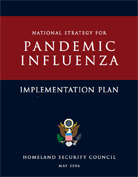Home /
Hazards / Influenza|
Hazards - Influenza - The Flu |
Influenza (commonly called “the flu”) is a contagious respiratory illness caused by influenza viruses. Infection with influenza viruses can result in severe illness and life-threatening complications. An estimated 10% to 20% of U.S. residents get the flu each year: an average of 114,000 people are hospitalized for flu-related complications and 36,000 Americans die each year from complications of flu.
In contrast to natural disasters -- in which critical components of the physical infrastructure may be threatened or destroyed -- an influenza pandemic may also pose significant threats to the human infrastructure responsible for critical community services due to widespread absenteeism in the workforce.
H1N1
What is influenza?
History
Emergency Management and Influenza
|
|
|


CDC Influenza Page
Weekly US Map: Influenza Summary Update

Implementation Plan
National Strategy for
Pandemic Influenza
|